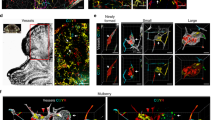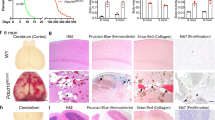Abstract
Cerebral cavernous malformations are vascular defects of the central nervous system consisting of clusters of dilated vessels that are subject to frequent hemorrhaging. The genes mutated in three forms of autosomal dominant cerebral cavernous malformations have been cloned, but it remains unclear which cell type is ultimately responsible for the lesion. In this article we describe mice with a gene trap insertion in the Ccm2 gene. Consistent with the human phenotype, heterozygous animals develop cerebral vascular malformations, although penetrance is low. β-galactosidase activity in heterozygous brain and in situ hybridization in wild-type brain revealed Ccm2 expression in neurons and choroid plexus but not in vascular endothelium of small vessels in the brain. The expression pattern of Ccm2 is similar to that of the Ccm1 gene and its interacting protein ICAP1 (Itgb1bp1). These data suggest that cerebral cavernous malformations arise as a result of defects in the neural parenchyma surrounding the vascular endothelial cells in the brain.






Similar content being viewed by others
References
Abbott NJ (2002) Astrocyte–endothelial interactions and blood–brain barrier permeability. J Anat 200: 629–638
Bergametti F, Denier C, Labauge P, Arnoult M, Boetto S, et al. (2005) Mutations within the Programmed Cell Death 10 gene cause cerebral cavernous malformations. Am J Hum Genet 76: 42–51
Brenner M, Kisseberth WC, Su Y, Besnard F, Messing A (1994) GFAP promoter directs astrocyte-specific expression in transgenic mice. J Neurosci 14: 1030–1037
Clatterbuck RE, Eberhart CG, Crain BJ, Rigamonti D (2001) Ultrastructural and immunocytochemical evidence that an incompetent blood–brain barrier is related to the pathophysiology of cavernous malformations. J Neurol Neurosurg Psychiatry 71: 188–192
Cyr M, Caron MG, Johnson GA, Laakso A (2005) Magnetic resonance imaging at microscopic resolution reveals subtle morphological changes in a mouse model of dopaminergic hyperfunction. NeuroImage 26: 83–90
Denier C, Gasc JM, Chapon F, Domenga V, Lescoat C, et al. (2002) Krit1/cerebral cavernous malformation 1 mRNA is preferentially expressed in neurons and epithelial cells in embryo and adult. Mech Dev 117: 363–367
Denier C, Goutagny S, Labauge P, Krivosic V, Arnoult M, et al. (2004) Mutations within the MGC4607 gene cause cerebral cavernous malformations. Am J Hum Genet 74: 326–337
Faisst AM, Gruss P (1998) Bodenin: a novel murine gene expressed in restricted areas of the brain. Dev Dyn 212: 293–303
Gault J, Shenkar R, Recksiek P, Awad IA (2005) Biallelic somatic and germ line CCM1 truncating mutations in a cerebral cavernous malformation lesion. Stroke 36: 872–874
Gunel M, Laurans MSH, Shin D, DiLuna ML, Voorhees J, et al. (2002) KRIT1, a gene mutated in cerebral cavernous malformation, encodes a microtubule-associated protein. Proc Natl Acad Sci U S A 99: 10677–10682
Guzeloglu–Kayisli O, Amankulor NM, Voorhees J, Luleci G, Lifton RP, et al. (2004a) KRIT1/cerebral cavernous malformation 1 protein localizes to vascular endothelium, astrocytes, and pyramidal cells of the adult human cerebral cortex. Neurosurgery 54: 943–949
Guzeloglu–Kayisli O, Kayisli UA, Amankulor NM, Voorhees JR, Gokce O, et al. (2004b) Krev1 interaction trapped-1/cerebral cavernous malformation-1 protein expression during early angiogenesis. J Neurosurg Spine 100: 481–487
Hof PR (2000) Comparative Cytoarchitectonic Atlas of the C57BL/6 J and 129/Sv Mouse Brains (Amserdam, New York: Elsevier)
Johnson GA, Cofer GP, Fubara B, Gewalt SL, Hedlund LW, et al. (2002) Magnetic resonance histology for morphologic phenotyping. J Magn Reson Imaging 16: 423–429
Kehrer–Sawatzki H, Wilda M, Braun VM, Richter HP, Hameister H (2002) Mutation and expression analysis of the KRIT1 gene associated with cerebral cavernous malformations (CCM1). Acta Neuropathol 104: 231–240
Laberge-le Couteulx S, Jung HH, Labauge P, Houtteville JP, Lescoat C, et al. (1999) Truncating mutations in CCM1, encoding KRIT1, cause hereditary cavernous angiomas. Nat Genet 23: 189–193
Liquori CL, Berg MJ, Siegel AM, Huang E, Zawistowski JS, et al. (2003) Mutations in a gene encoding a novel protein containing a phosphotyrosine-binding domain cause type 2 cerebral cavernous malformations. Am J Hum Genet 73: 1459–1464
Maronpot RR, Sills RC, Johnson GA (2004) Applications of magnetic resonance microscopy. Toxicol Pathol 2: 42–48
McCarty JH, Lacy–Hulbert A, Charest A, Bronson RT, Crowley D, et al. (2005) Selective ablation of alphav integrins in the central nervous system leads to cerebral hemorrhage, seizures, axonal degeneration, and premature death. Development 132: 165–176
Moriarity JL, Clatterbuck RE, Rigamonti D (1999) The natural history of cavernous malformations. Neurosurg Clin North Am 10: 411–417
Plummer NW, Gallione CJ, Srinivasan S, Zawistowski JS, Louis DN, et al. (2004) Loss of p53 sensitizes mice with a mutation in Ccm1 (KRIT1) to development of cerebral vascular malformations. Am J Pathol 165: 1509–1518
Plummer NW, Zawistowski JS, Marchuk DA (2005) Genetics of cerebral cavernous malformations. Curr Neurol Neurosci Rep 5: 391–396
Sahoo T, Johnson EW, Thomas JW, Kuehl PM, Jones TL, et al. (1999) Mutations in the gene encoding KRIT1, a Krev-1/rap1a binding protein, cause cerebral cavernous malformations (CCM1). Hum Mol Genet 8: 2325–2333
Schaeren–Wiemers N, Gerfin–Moser A (1993) A single protocol to detect transcripts of various types and expression levels in neural tissue and cultured cells: in situ hybridization using digoxigenin-labelled cRNA probes. Histochemistry 100: 431–440
Serini G, Bussolino F (2004) Common cues in vascular and axon guidance. Physiology 19: 348–354
Uhlik MT, Abell AN, Johnson NL, Sun W, Cuevas BD, et al. (2003) Rac–MEKK3–MKK3 scaffolding for p38 MAPK activation during hyperosmotic shock. Nat Cell Biol 5: 1104–1110
Urness LD, Li DY (2004) Wiring the vascular circuitry: from growth factors to guidance cues. In: Current Topics in Developmental Biology 62, Schatten GP (ed). (New York: Academic Press), pp 87–126
Valverde F (1998) Golgi Atlas of the Postnatal Mouse Brain (New York: Springer Verlag)
Whitehead KJ, Plummer NW, Adams JA, Marchuk DA, Li DY (2004) Ccm1 is required for arterial morphogenesis: implications for the etiology of human cavernous malformations. Development 131: 1437–1448
Wong JH, Awad IA, Kim JH (2000) Ultrastructural pathological features of cerebrovascular malformations: a preliminary report. Neurosurgery 46: 1454–1459
Zabramski JM, Henn JS, Coons S (1999) Pathology of cerebral vascular malformations. Neurosurg Clin North Am 10: 395–410
Zawistowski JS, Serebriiskii IG, Lee MF, Golemis EA, Marchuk DA (2002) KRIT1 association with the integrin-binding protein ICAP-1: a new direction in the elucidation of cerebral cavernous malformations (CCM1) pathogenesis. Hum Mol Gen 11: 389–396
Zawistowski JS, Stalheim L, Uhlik MT, Abell AN, Ancrile BB, et al. (2005) CCM1 and CCM2 protein interactions in cell signaling: implications for cerebral cavernous malformations pathogenesis. Hum Mol Genet 14: 2521–2531
Zhang J, Clatterbuck RE, Rigamonti D, Chang DD, Dietz HC (2001) Interaction between krit1 and icap1alpha infers perturbation of integrin beta1-mediated angiogenesis in the pathogenesis of cerebral cavernous malformation. Hum Mol Genet 10: 2953–2960
Acknowledgments
This work was supported by NIH grant NS-43543 and American Heart Association Bugher Foundation Award for the Investigation of Stroke 0070028 N to DAM. Cheryl Bock and the Duke University Transgenic Mouse Facility cultured the RRG051 embryonic stem cells and generated the chimeric mice. The authors thank Hai Yan Lin, Momoka Matsunami, Quiyi Chi, and Natasha Thorne for technical assistance, and Christopher Clayton for help with mouse colony maintenance.
Author information
Authors and Affiliations
Corresponding author
Additional information
Nicholas W. Plummer, Teresa L. Squire and Sudha Srinivasan contributed equally to this work.
Rights and permissions
About this article
Cite this article
Plummer, N.W., Squire, T.L., Srinivasan, S. et al. Neuronal expression of the Ccm2 gene in a new mouse model of cerebral cavernous malformations. Mamm Genome 17, 119–128 (2006). https://doi.org/10.1007/s00335-005-0098-8
Received:
Accepted:
Published:
Issue Date:
DOI: https://doi.org/10.1007/s00335-005-0098-8




